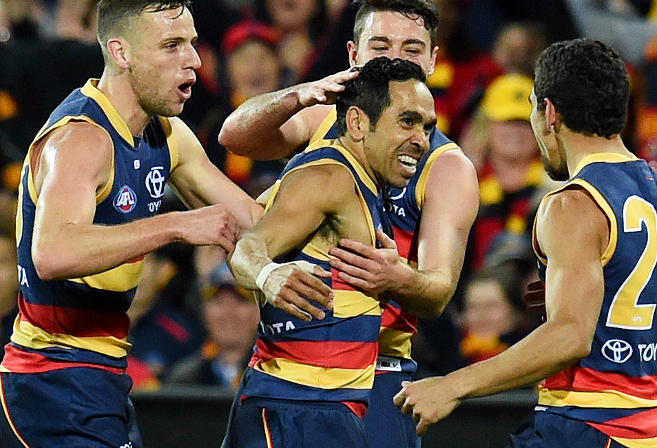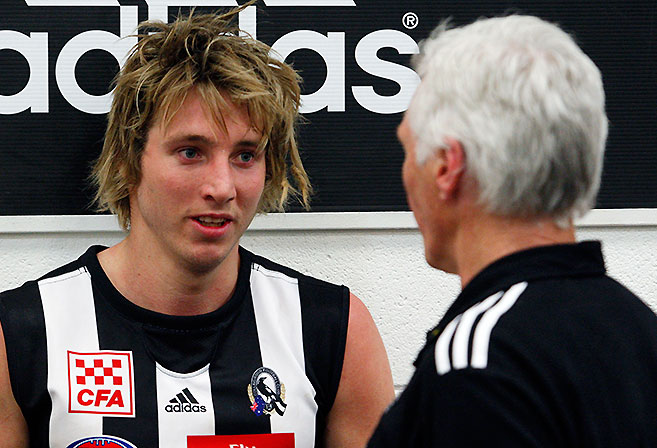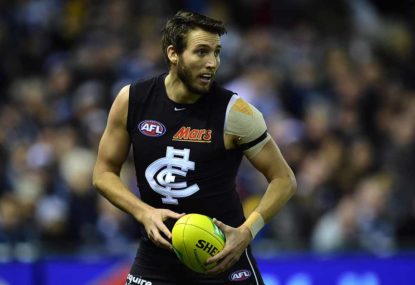On Tuesday, it was revealed that Dale Thomas and his management agreed to remove the trigger clause in his contract. The disintegration of the contract is a win-win-win.
That’s three wins for three parties.
The first win is for Carlton. The Blues free up a spot and cap space on a list skewing younger and not-Daisy Thomas. The second win is for Daisy himself. He trades in a year of Carlton purgatory for post-football goodwill. Goodwill is valuable currency. Daisy can seamlessly transition to a media role as a nouveau Shane Crawford or maybe a pupaic Billy Brownless.
Win three is for me, Ken Sakata. I get to eulogise the worst AFL contract in recent memory. I expect to feel better anytime now. I’ve pegged all personal development to the end of bad Carlton contracts. When the Liam Jones deal ends, I might take up salads and yoga.
The Daisy Thomas deal (RIP 2013-2017) is a disaster. If you believe all sports media, the Daisy Thomas deal is not only a cautionary tale for list managers but a complete 100 per cent disaster.
If you bought a Tesla but received a Volkswagen, that’s probably a 50 per cent disaster. If you get a Toyota, that’s an 80 per cent disaster. If you buy a Tesla but receive a signed Delta Goodrem CD – any album – that’s a 100 per cent disaster.
No doubt, you’ve been inundated with details of the ill-fated contract. A better writer would spare you and skip ahead. But I’ll need to run it back. I need the pain to feel alive again.
It’s 2013. AFL free agency. Carlton had to choose between keeping small forward Eddie Betts and poaching Dale Thomas from arch-nemesis Collingwood. Daisy had a newly reconstructed ankle, which is a good or a bad thing, depending on whether you know anything about medicine. Carlton chose Daisy for a reported 700k a year. Eddie went to Adelaide for 500k.
It’s 2017. Eddie Betts has lead the goal-kicking at Adelaide every year he’s been there. Eddie Betts has a forward pocket named after him at Adelaide Oval. Eddie Betts is now a two-time All-Australian.

(AAP Image/Tracey Nearmy)
Daisy? 2.1 million dollars later, it’s debatable if he’s best used as an average AFL player or an incredible VFL player.
I was right about the pain, I feel more alive than ever.
As a footballing decision, the failure of the Daisy Thomas deal has inspired a complete philosophical change in Carlton’s list management. No more poaching expensive free agents, no more fiscal irresponsibility. Carlton decided to join the rest of modern football with a cost-effective commitment to drafting and developing in-house. It could work. They once did it with a teenage Eddie Betts.
All indications point to it paying off. This past weekend, a win over Collingwood featured an electric performance by seven-gamer Samo Petrevski-Seton, poetically echoing the energy of a Collingwood-era Daisy Thomas.
Daisy’s best football at Collingwood has always been inexorably linked to his off-field persona: vibrant, daring and magnetic. He was everywhere at once, running down forwards in the back pocket and snapping goals up front. Revisionists would have him benefiting from a midfield of Swan, Pendlebury and Beams. But at his peak, he possessed qualities beyond them. Daisy was a genuine match-winner.
With Thomas, Carlton had bought the Collingwood blueprint of success. Thomas was brought in to play behind Marc Murphy and Chris Judd. It would shield him from a tagger-heavy competition to thrive as Carlton’s x-factor and match-winner.

Image: AAP
Although he played 20 games in his first season, Thomas was never close to his mercurial best. The new Daisy was trying, he just wasn’t very good. Maybe it was the lack of pre-season, maybe it was the new team. Maybe it was the reconstruction.
Fears began to mount that his troublesome ankle had drastically lowered the ceiling of his ability.
Conscious of his limitations, coach Mick Malthouse began playing Thomas as a defensive forward against the more dynamic half-backs of the competition. The tagged had become a tagger. It seemed like a quizzical and utterly unimaginative use for a former star player of the league.
Malthouse would be sacked early in 2015 after a premiership tilt turned into crumbling mediocrity. Thomas would suffer a season-ending shoulder injury three days later.
The appointment of Brendon Bolton has focused on the development of a younger core of players. The shifting narrative of Daisy Thomas is being re-written again. In defence to criticism against Thomas this year, Bolton said he was valued for setting training standards and his contributions to team meetings.
In 2017, the last year of his contract, it’s debatable if there’s a role for Daisy Thomas in Carlton’s best 22.
Unlike the Tom Boyd deal, the last contract to come under scrutiny, Daisy Thomas won’t be afforded a last transformative act. There will no grand final, no final reprieve. The enduring opinion of its success will, unfortunately, be its definitive one.
The deal will be remembered by Carlton’s front office incompetence and its underestimation of Daisy’s injury history.
It’s important to note that neither were in Thomas’ control. It’s hard to begrudge a man who tried hard at a job he was overpaid to do.































































































